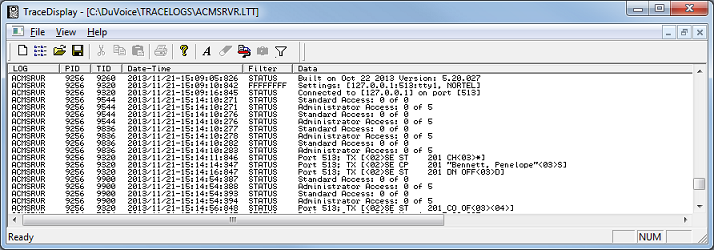|
Traffic over the hospitality PBX link is typically logged to either the ACMSRVR log or the PBXSERVICE log, depending on the PBX connector.
The table below summarizes which PBX types log to which log file. Since Vodavi only supports inband short codes, and not an actual dedicated link, all logging for Vodavi is in the individual LINE logs.
Log File Prefix
|
PBX Link(s) That Log To This Log File
|
ACMSRVR
|
Aeonix
Alcatel OmniPCX Enterprise (OXE)
Alcatel OmniPCX Office (OXO)
Avaya ACM
Mitel 3300
NEC SV8100 / SV9100 (KTS-i)
NEC SV9300 / SV9500 (NEAX Model 60)
Nortel / CS1000
|
CISCO
|
Cisco CUCM
|
HOSTEL
|
Univerge 3C
|
HTTPPOST
|
HTTP Name Service
IPitomy
|
IPOFFICE
|
Avaya IP Office
|
IPOSRVR
|
Panasonic KXTDE / NSXXX
|
METASWITCH
|
Metaswitch
|
SHORETEL
|
ShoreTel
|
SIEMENS
|
Siemens OpenScape
|
LINEn
|
Vodavi
|
Log files use the file extension .LTT and are stored in the path C:\DuVoice\TRACELOGS.
Each night around midnight, the log files "roll over," meaning the current log ACMSRVR.LTT is renamed as ACMSRVR-YYYYMMDD0000.LTT, or something similar, where YYYYMMDD is the year, month and day of the content of the file (that is, the date that most or all of the log entries were logged). Older files are moved to the ARCHIVE sub-folder.
Log files may be viewed using the Trace Display application, shown below. Refer to the Trace Display page for more details on using this utility.

The example above is for the ACMSRVR log, showing part of a session for a Nortel link. The primary difference between the ACMSRVR, PBXSERVICE and LINE logs is the information displayed in the Data column, the details of which are beyond the scope of this document.
The log file contains the following fields, shown as columns in the dialog above.
Column
|
Description
|
Log
|
The base name that identifies which log the entry was logged to.
For the PMS link log, this will always be PMSLINK followed by the server instance number. In most cases, it would be PMSLINK1.
|
PID
|
The process ID of the process from which the log entry was generated.
|
TID
|
The thread ID of the thread from which the log entry was generated.
|
Date-Time
|
The date and time when the log entry was logged.
Format is Year/Month/Day-Hour/Min/Sec.msec.
All values are padded with leading zeros; the millisecond value is padded to three digits and all others to two digits. The hour value is always in 24-hour clock notation.
|
Filter
|
Filter level. Can be ignored.
|
Data
|
The actual log statement generated by the service.
Log statements can be a little cryptic and are generally intended as a debugging aid for the manufacturer's technicians and developers. Still, they can sometimes be useful even to on-site technicians to verify or troubleshoot certain issues.
The data displayed will differ depending on the PBX type and how it is connected (serial, TCP, TAPI or inband), as well as which log file is being viewed. For example, the LINE logs also display call traffic, both inbound and outbound.
Logging for the Vodavi restrict and unrestrict short codes will only occur in the LINE logs for voice ports that have been assigned to perform notifications (in the Location settings).
|
|





